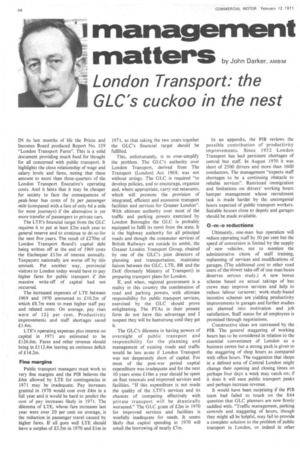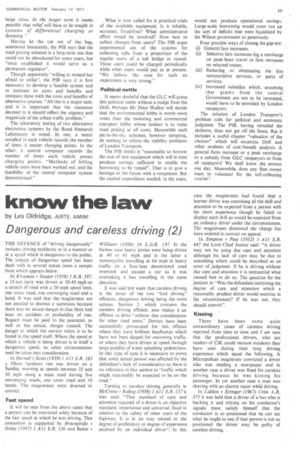management
Page 56

Page 57

If you've noticed an error in this article please click here to report it so we can fix it.
matters by John Darker, AMBIM
London Transport: the GLC's cuckoo in the nest
IN its last months of life the Prices and Incomes Board produced Report No. 159 "London Transport Fares". This is a solid document providing much food for thought for all concerned with public transport. It highlights the close relationship of wage and salary levels and fares, noting that these amount to more than three-quarters of the London Transport Executive's operating costs. And it hints that it may be cheaper for society to face the consequences of peak-hour bus costs of 5s per passenger mile (compared with a fare of only 6d a mile for most journeys) if the alternative is yet more transfer of passengers to private cars.
The LTE's financial target from the GLC requires it to put at least £2m each year to general reserve and to continue to do so for the next five years. The result of £270m of London Transport Board's capital debt being written off at the end of 1969 costs the Exchequer £13m of interest annually. Taxpayers nationally are worse off by this amount. Put another way, provincial visitors to London today would have to pay higher fares for public transport if this massive write-off of capital had not occurred.
The incteased expenses of LTE between 1969 and 1970 amounted to £10.2m of which £8.7m went to meet higher staff pay and related costs. On average, pay rises were of 124 per cent. Productivity improvements and staff shortages saved £1.4m.
LTE's operating expenses plus interest on capital in 1971 are estimated to be £126.6m. Fares and other revenue should bring in £112.4m leaving an ominous deficit of £14.2m.
Fine margins Public transport managers must work to very fine margins and the PIB believes the £4m allowed by LTE for contingencies in 1971 may be inadequate. Pay increases granted in 1970 would cost over £4m in a full year and it would be hard to predict the cost of pay increases likely in 1971. The dilemma of LTE, whose fare increases last year were over 20 per cent on average, is the reduction in passenger travel caused by higher fares. If all goes well LTE should have a surplus of £3.5m in 1970 and Lim in 1971, so that taking the two years together the GLC's financial target should be fulfilled.
This, unfortunately, is to over-simplify the problem. The GLC's authority over London Transport, derived from The Transport (London) Act 1969, was not without strings. The GLC is required "to develop policies, and to encourage, organize and, where appropriate, carry out measures, which will promote the provision of integrated, efficient and economic transport facilities and services for Greater London". With ultimate authority over most of the traffic and parking powers exercised by London Boroughs the GLC is probably equipped to fulfil its remit from the state. It is the highway authority for all principal roads and though the commuter services of British Railways are outside its ambit, the Greater London Transport Group, chaired by one of the GLC's joint directors of planning and transportation, maintains liaison between the GLC, LTE, BR and the DoE (formerly Ministry of Transport) in preparing transport plans for London.
If, and when, regional government is a reality in this country the combination of road and parking powers, with ultimate responsibility for public transport services, exercised by the GLC should prove enlightening. The PTAs in their present form do not have this advantage and I suspect they will be hamstrung until they get it.
The GLC's dilemma in having powers of oversight of public transport and responsibility for the planning and management of existing roads and traffic would be less acute if London Transport was not desperately short of capital. For most of the post-war period capital expenditure was inadequate and for the next 10 years some £10m a year should be spent on fleet renewals and improved services and facilities. "If this expenditure is not made the quality of the LTE's services and its chances of competing effectively with private transport will be drastically worsened." The GLC grant of £2m in 1970 for improved services and facilities is woefully inadequate for needs. It seems likely that capital spending in 1970 will entail the borrowing of nearly £7m. In an appendix, the PIB reviews the possible contribution of productivity improvements. Since 1952 London Transport has had persistent shortages of central bus staff. In August 1970 it was short of 2500 drivers and more than 1600 conductors. The management "expects staff shortages to be a continuing obstacle to reliable services". Restricted immigration and limitations on drivers' working hours hamper management whose recruitment task is made harder by the uncongenial hours expected of public transport workers. Suitable houses close to depots and garages should be made available.
0-m -o reductions
Ultimately, one-man bus operation will reduce operating staff by 50 per cent but the speed of conversion is limited by the supply of new vehicles, not to mention the administrative chore of staff training, replanning of services and modifications of garages. (The additional cost to other road users of the slower take-off of one-man buses deserves serious study.) A new bonus scheme based on actual takings of bus crews may improve services and help to reduce labour turnover; work-study-based incentive schemes are yielding productivity improvements in garages and further studies are planned into motivation and job satisfaction. Staff status for all employees is promised through negotiations.
Constructive ideas are canvassed by the , PIB. The general staggering of working hours has to be considered in relation to the essential convenience of London as a business centre but a strong push is given to the staggering of shop hours as compared with office hours. The suggestion that shops in a defined area of Central London might change their opening and closing times on perhaps four days a week may catch on; if it does it will ease public transport peaks and perhaps increase revenue.
It would have been surprising if the PIB team had failed to touch on the $64 question that GLC planners are now firmly saddled with. "Traffic management, parking controls and staggering of hours, though they might all be helpful, may fail to provide a complete solution to the problem of public transport in London, or indeed in other
large cities. In the longer term it seems possible that relief will have to be sought in systems of differential charging or licensing."
Having let the cat out of the bag, somewhat hesistantly, the PIE says that the road-pricing solution is a long-term one that could not be introduced for some years, but "once established it would serve as a permanent regulator".
Though apparently "willing to wound but afraid to strike", the PIB says it is first necessary to develop a feasible system and to estimate its costs and benefits and compare these with the costs and benefits of alternative courses. "All this is a major task, and it is important that the resources devoted to it should reflect the urgency and magnitude of the urban traffic problem."
The laboratory testing of two alternative electronics systems by the Road Research Laboratory is noted. In one, a meter installed in each vehicle records the number of times it passes charging points. In the other, a central computer records the number of times each vehicle passes charging points. "Methods of billing vehicle-users have been worked out, and the feasibility of the central computer system demonstrated." What is now called for is practical trials of the available equipment. Is it reliable, accurate, fraud-free? What administrative effort would be involved? How best to collect charges from users? The PIB urges experimental use of the systems for collecting tolls from a proportion of the regular users of a toll bridge or tunnel. These users could be charged periodically while other users would pay as at present. "We believe the case for such an experiment is very strong."
Political nettle It seems doubtful that the GLC will grasp this political nettle without a nudge from the DoE. Perhaps Mr Peter Walker will decide that the environmental lobby is worth more votes than the motoring and commercial transport lobby whose instinct is to resist road pricing at all costs. Meanwhile such pie-in-the-sky schemes, however tempting, do nothing to relieve the viability problems of London Transport.
The PIB thinks it "reasonable to borrow the cost of new equipment which will in time produce savings sufficient to enable the borrowing to be repaid". That is to give a hostage to the future with a vengeance. But the capital expenditure needed, in the main, would not produce operational savings. Large-scale borrowing would soon run up the sort of deficits that were liquidated by the Wilson government so generously.
Four possible ways of closing the gap are: (i) General fare increases.
(ii) Selective fare increases (eg a surcharge on peak-hour travel or fare increases on selected routes.
(iii) Reducing or eliminating the less remunerative services, or parts of services.
(iv) Increased subsidies which, assuming that grants from the central Government are not to he increased, would have to be provided by London ratepayers.
The solution of London Transport's problem calls for political and economic judgment. The PIE, having revealed the skeleton, does not get off the fence. But it includes a useful chapter "valuation of the choices" which will excercise DoE and other students of cost /benefit analysis. A general fares increase or a peak surcharge or a subsidy from GLC ratepayers or from all taxpayers! We shall know the answer one day. Meanwhile, does any fleet owner want to volunteer for the toll-collecting routine?
































































































